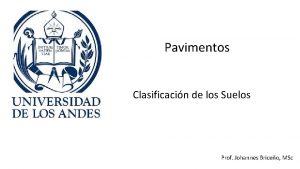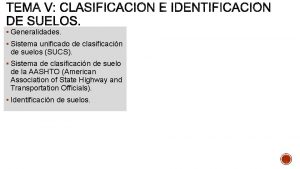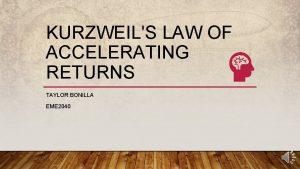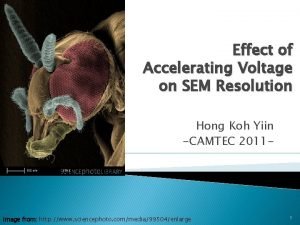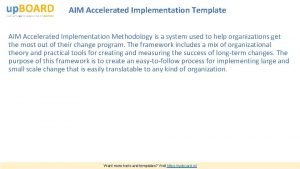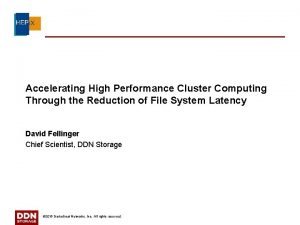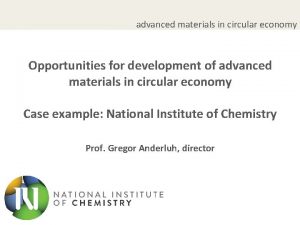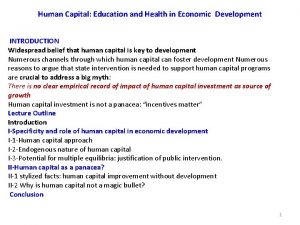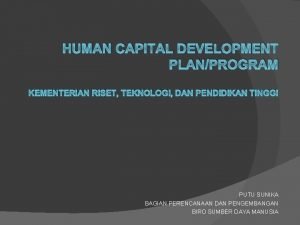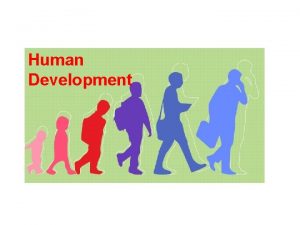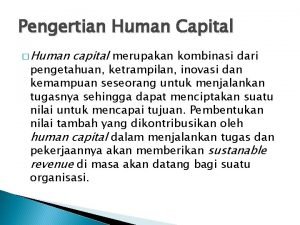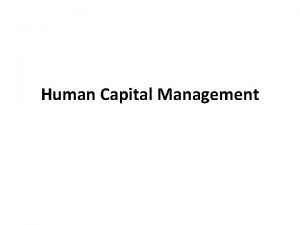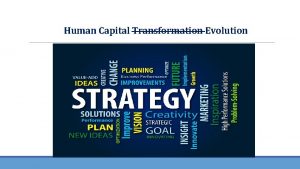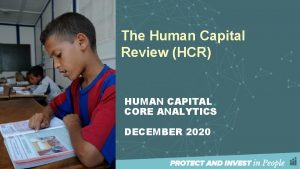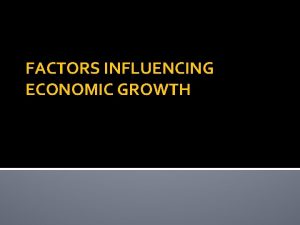Role of SUCs in Accelerating Human Capital Development











- Slides: 11

Role of SUCs in Accelerating Human Capital Development Golden Prince Hotel November 23, 2017

Accelerating Human Capital Development Chapter 10 - Philippine Development Plan

BACKGROUND Equalizing opportunities for human development is an important part of Philippine Development Plan (PDP). Under the Pillar Pagbabago, the PDP recognizes human development not just as a means to an end but also as end in itself.

STRATEGIC FRAMEWORK The Philippine Development Plan 20172022 aims to reduce inequalities in human development outcomes. In particular it aims to improve nutrition and health for all, ensure lifelong learning opportunities for all, and increase the income-earning ability of Filipinos

Issues in Higher Education The higher education system is beset by stubborn issues which, in light of 21 st century challenges, require urgent, tactical, and transformative solutions 1. Lack of faculty with advance degrees 2. Low number of HEIs with accredited programs and low national passing percentage in licensure examination 3. Poor quality of graduate programs and inadequate attention to research and technological innovations have reinforced a deficient science and innovation culture and lack of interest among young Filipinos to pursue scientific, engineering, and technical studies

Issues in Higher Education 4. Mismatch between higher education and industry requirements that is attributed to a. underdeveloped 21 st century competencies among graduates b. adherence to a teacher-centered and input-based education paradigm c. the uncritical application of the evolving quality standards of the universities ( e. g. publications in peer reviewed journals) to Philippine HEIs regardless of mission, thus resulting in watered-down standards for universities and inefficiencies in other types of HEIs (allocation of funds for token research centers instead of laboratories) 5. Organizational issues within the bureaucracy and questionable practices

Higher Education Targets to Ensure Lifelong Learning Opportunities for All Annual Target Baseline Data (2016) 2017 2018 2019 2020 2021 2022 5. 00% 6. 50% 7. 50% 8. 50% 9. 50% 10. 00% 2. Percentage of tertiary graduates in science, engineering, manufacturing and construction 26% 28% 31% 33% 35% 38% 40% 3. Percentage of ETEEAP graduates 50% 51. 5% 53% 54. 5% 56% 58% 60% 0. 17% 0. 20% 0. 25% 0. 30% 0. 35% 0. 40% 0. 50% 231 275 320 365 400 450 500 INDICATORS 1. Percentage of students awarded scholarships, grants, and other financial assistance 4. Increased government expenditures for higher education research, development and innovation 5. Increased number of patents, licenses and royalties issued to HEIs 6. Increased number of researchers and scientists 8 1, 1 1, 42 1, 72 2, 3 2, 013 41 30 5 0 00 2, 600

Higher Education Targets to Ensure Lifelong Learning Opportunities for All INDICATORS 7. Number of curricula and programs developed/revised based on multi-disciplinal platforms that foster 21 st century competencies Baseline Data (2016) Annual Target 2017 2018 2019 2020 2021 2022 8 9 72 75 0 85 0 95 100 8. Increased number of HEIs engaged in local and global partnerships and collaborations 44 9. Increased number of graduate education graduates (MA/Ph. D) engaged in original research of creative work 6, 7, 66 8, 2 8, 830 500 080 5 50 9, 4 20 10, 000 10. Increased number of innovation hubs established within HEIs 81 139 55 93 65 104 70 116 80 127 90 100 150

Higher Education Targets to Increase Income Earning Ability INDICATORS 1. Number of youth NEET assisted 2. Number of policies, specifically under UNIFAST implemented to provide college-age youth access to higher education 3. Decreased duration of school-towork transition of college graduate 4. Number of higher education policies formulated to produce work-ready higher education graduates Annual Target Baseline Data (2016) 2017 2018 2019 2020 2021 41, 000 60, 000 2 2 2 years 9 month s 10 10

Higher Education Targets to Increase Income Earning Ability INDICATORS Baseline Data (2016) Annual Target 2017 2018 2019 2020 2021 5. Increased number of HE graduates 44 525, 00 570, 615, 0 655, 70 485, 000 engaged in job collaboration 0, 000 00 000 0, 000 6. Number of policies implemented to produce graduates who are holistically-developed and civic 1 minded critical thinkers, lifelong 1 learners, innovators, job creators and entrepreneurs 7. Percentage of females with 12. 71% 14% 15% 16% 18% 19% 20% advanced degrees employed (%) 8. Number of female students enrolled in advance education program 12 135, 00 140, 145, 0 150, 15 130, 000 5, 400 000 5, 000

THANK YOU
 Clasificación de suelos aashto y sucs
Clasificación de suelos aashto y sucs Sistema sucs
Sistema sucs Classificação dos solos (sucs)
Classificação dos solos (sucs) Chimie digestive
Chimie digestive Accelerating rate calorimeter
Accelerating rate calorimeter Law of accelerating returns
Law of accelerating returns 50000x200
50000x200 Accelerated implementation methodology
Accelerated implementation methodology Accelerating high performance
Accelerating high performance Advanced materials
Advanced materials Human capital education and health in economic development
Human capital education and health in economic development Human capital development plan
Human capital development plan
